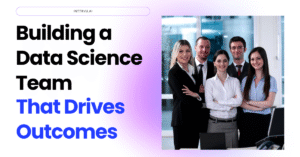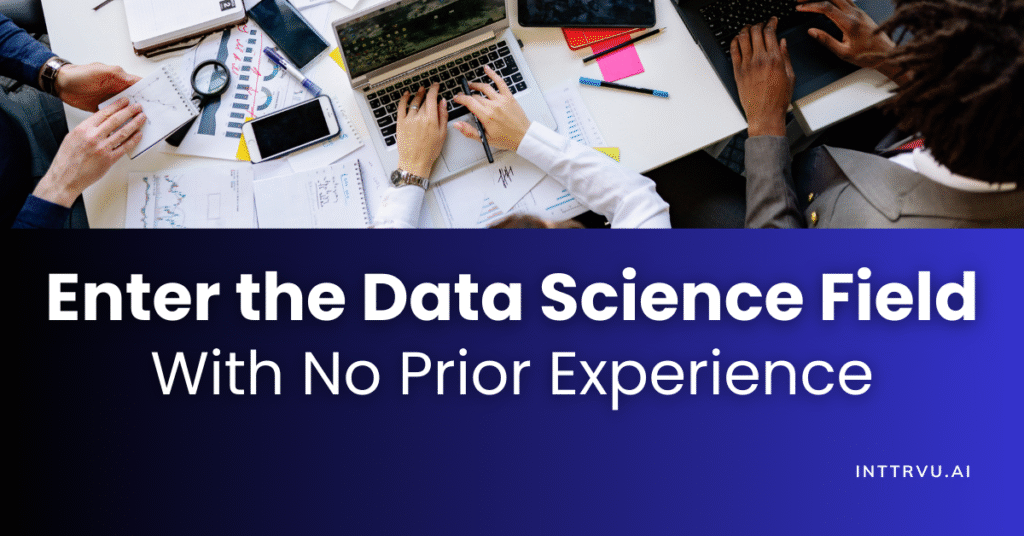Enter the Data Science Field with No Prior Experience
Introduction
Data science has emerged as one of the most in-demand career paths of the decade. Organizations across industries, technology, finance, healthcare, manufacturing, e-commerce, and retail, are actively seeking professionals who can work with data, uncover patterns, and deliver actionable insights that drive business growth.
The explosion of data from digital transformation, IoT devices, and online platforms has made data science skills a must-have for businesses that want to stay competitive. Today, companies need experts who can not only analyze large datasets but also interpret results, visualize insights, and communicate findings to decision-makers in a way that impacts strategy.
A common misconception is that only individuals with strong technical backgrounds, computer science degrees, or prior industry experience can succeed in data science. The truth is that data science is an inclusive, skill-based profession. Whether you are from finance, marketing, engineering, or even a completely non-technical field, you can successfully enter this domain by following a structured learning path.
Enrolling in a data science course can give you the foundation you need, from Python programming and statistics to SQL and machine learning, while helping you gain hands-on experience through projects. Combined with consistent practice and a well-curated portfolio, a good data science course can accelerate your journey and help you transition into this exciting and high-growth career.
Why Data Science Welcomes Beginners
One of the most attractive features of data science is its interdisciplinary nature. It brings together multiple skill areas, including:
- Programming to manipulate and analyze data.
- Statistics and Mathematics to understand trends and validate findings.
- Business Knowledge to contextualize insights and make them actionable.
- Communication and Storytelling Skills to present results effectively to stakeholders.
Employers today value problem-solving ability, curiosity, and adaptability over formal education or years of prior experience. Many professionals from finance, marketing, operations, HR, and even the humanities have made successful transitions into data science roles. Their domain expertise often becomes a unique advantage, as it allows them to approach business problems with practical insights.
Step 1: Build Strong Fundamentals
Before diving into machine learning or AI, you need a solid foundation in core skills.
Programming:
To build a strong foundation in data science, start with Python programming, which is the industry standard. Python is popular because it is beginner-friendly and has a rich ecosystem of libraries such as Pandas, NumPy, and Scikit-learn that make data analysis, visualization, and modeling much easier.
If you are new to coding, start with a Python language course that covers the basics syntax, variables, loops, and functions, before moving on to more advanced concepts like object-oriented programming and data manipulation. The goal is to learn Python language not just theoretically, but through hands-on practice.
You can also explore python coding exercises daily to strengthen your understanding and build problem-solving skills. Once comfortable with Python, you can advance to a machine learning course or machine learning classes that teach you how to build predictive models and solve real-world problems.
While Python is the preferred choice, R remains a good option for those inclined toward statistical modeling or academic research.
Statistics & Probability: Focus on descriptive statistics (mean, median, standard deviation), probability distributions, hypothesis testing, and regression analysis. These are crucial for understanding data behavior and validating model results.
SQL: Master querying techniques such as SELECT, JOIN, GROUP BY, and subqueries to handle structured data from databases efficiently.
Excel: Despite being a basic tool, Excel is widely used for data exploration, reporting, and initial analysis, especially in business environments.
A strong foundation here ensures that you can progress smoothly to advanced topics like machine learning and deep learning without feeling lost.
Step 2: Learn Through Projects
Theory is essential for understanding concepts, but true expertise in data science comes from applying what you learn to real problems. Hands-on projects help bridge the gap between theory and practice, strengthen problem-solving skills, and give you concrete work to showcase in your portfolio.
The key is to start small and gradually increase complexity as your skills improve.
1. Exploratory Data Analysis (EDA)
EDA is often the first step in any data science project. It involves cleaning, exploring, and summarizing data to find meaningful insights. Examples of EDA Projects:
- Sales Analysis: Use retail data to identify top-performing products, monthly trends, and customer purchasing patterns.
- HR Analytics: Analyze employee attrition data to find factors leading to high turnover.
- Social Media Data: Explore engagement data (likes, shares, comments) to determine which content performs best.
What You Learn: Data cleaning, handling missing values, summary statistics, feature understanding, and visualization.
2. Visualization Projects
Good data scientists don’t just find insights, they communicate them clearly. Visualization projects help develop skills in storytelling and dashboard design.
Examples of Visualization Projects:
- Business Dashboard: Build a Tableau or Power BI dashboard to show sales by region, product category, and seasonality.
- Healthcare Dashboard: Visualize patient admission trends, average length of stay, and hospital occupancy rates.
- Finance Dashboard: Track stock market data, portfolio returns, or expense tracking over time.
What You Learn: Data visualization best practices, KPI selection, dashboard interactivity, and presenting results in a business-friendly manner.
3. Predictive Modeling Projects
Once you are comfortable with EDA and visualization, progress to predictive analytics using machine learning algorithms.
Examples of Predictive Projects:
- Customer Churn Prediction: Use Logistic Regression or Random Forest to predict which customers are likely to stop using a service.
- House Price Prediction: Apply Linear Regression to predict prices based on features like size, location, and number of rooms.
- Credit Risk Modeling: Classify loan applicants as “low risk” or “high risk” using classification models.
- Demand Forecasting: Build a time series model (ARIMA) to predict future product demand.
What You Learn: Data preprocessing, feature engineering, model selection, performance evaluation (accuracy, precision, recall), and tuning hyperparameters.
4. Advanced/Portfolio-Ready Projects
As you gain confidence, take on projects that combine multiple skills and involve end-to-end pipelines.
Examples of Advanced Projects:
- Recommendation System: Build a movie or product recommendation engine using collaborative filtering.
- Sentiment Analysis: Analyze customer reviews or tweets to classify sentiment as positive, negative, or neutral using NLP techniques.
- Fraud Detection: Detect fraudulent transactions using anomaly detection methods.
- Image Classification: Use deep learning (CNNs) to classify images, such as recognizing handwritten digits (MNIST dataset).
What You Learn: Deploying models, handling large datasets, integrating machine learning with applications, and working with unstructured data (text/images).
5. Competitions and Open Datasets
Platforms like Kaggle, DrivenData, and the UCI Machine Learning Repository provide high-quality datasets and challenges that simulate real-world problems. Participating helps you:
- Compete with data scientists globally.
- Learn from shared solutions and notebooks.
- Get familiar with industry-level problem-solving approaches.
Best Practices for Project Documentation
Recruiters and hiring managers value clear, professional documentation. For every project:
- State the Problem Clearly: What business question are you trying to answer?
- Explain Your Approach: Detail your data cleaning steps, modeling techniques, and why you chose them.
- Show Results: Present visualizations, metrics, and key findings in an easy-to-understand format.
- Reflect on Learnings: Note challenges faced and how you solved them.
This approach shows not just technical skills but also your ability to think critically and communicate effectively, key traits for a data scientist.
Step 3: Utilize Accessible Learning Resources
You do not need an expensive degree to learn data science. What you need is structured guidance, hands-on practice, and consistent effort. Several high-quality and affordable learning resources are available that allow you to learn at your own pace while staying industry-relevant.
Recommended Resources:
- INTTRVU.AI Programs: Specialized programs that focus on practical, job-ready skills in data science, AI, and interview preparation. These include 1:1 mock interviews, live online classes, and dual certification opportunities to help you bridge the gap between learning and landing a job.
- Kaggle Learn: Free interactive lessons on Python, SQL, machine learning, and data visualization.
- YouTube Tutorials: Explore beginner-friendly channels that explain concepts visually and step-by-step.
Step 4: Build a Professional Portfolio
A well-crafted portfolio is one of the most powerful tools you can use to stand out in the data science job market. While a resume lists your skills, a portfolio shows them in action, helping recruiters and hiring managers quickly assess your problem-solving abilities and real-world experience.
Here’s how you can create an impactful portfolio:
1. Create Well-Documented GitHub Repositories
Your GitHub should be the first stop for anyone who wants to review your work.
- Organize Projects Clearly: Use separate folders for each project with descriptive names.
- Include a README File: Every project should have a README that explains:
- The problem statement
- Data sources used
- The approach you took (step-by-step)
- Key findings or results
- Visualizations or dashboards (screenshots if possible)
- Use Version Control: Commit changes regularly, showing how your project evolved over time.
Example Projects for GitHub:
- Exploratory Data Analysis (EDA): Customer segmentation analysis for a retail dataset.
- Predictive Modeling: Predicting loan approvals using Logistic Regression or Random Forest.
- End-to-End Pipeline: Automating data cleaning and feature engineering using Python and Airflow.
2. Showcase Your Learning on LinkedIn
LinkedIn is more than just a networking site, it’s a platform to build credibility.
- Post about projects you finish: Share your thought process, screenshots of dashboards, or key insights.
- Write short reflections: Explain what you learned, what challenges you faced, and how you solved them.
- Engage with the community: Comment on other people’s posts, answer questions, and participate in discussions.
Why this matters: Recruiters often search for candidates on LinkedIn, and your posts act as proof of your skills and passion for data science. Refer to the LinkedIn Profile Guide for better understanding.
3. Write Blogs Explaining Your Approach
Blogging is an underrated way to demonstrate communication skills, a crucial requirement for data scientists.
- Choose a platform like Medium or Hashnode, or publish directly on LinkedIn Articles.
- Break down your projects in simple, structured language so non-technical readers can understand them.
- Include visuals, charts, graphs, and code snippets, to make your explanation engaging.
Example Blog Ideas:
- “How I Used Machine Learning to Predict Customer Churn”
- “5 Key Insights I Found from Analyzing Sales Data”
- “Step-by-Step Guide to Cleaning a Messy Dataset with Pandas”
4. Combine Everything into a Portfolio Website (Optional but Recommended)
A personal website creates a professional impression and serves as a one-stop showcase for recruiters.
- Include links to GitHub repositories, blogs, and dashboards.
- Add a short bio highlighting your skills, career goals, and contact details.
- Keep the design clean, minimal, and mobile-friendly.
Step 5: Gain Practical Exposure and Network
Industry exposure bridges the gap between theory and practice. You can:
- Join professional communities and local meetups.
- Participate in hackathons or virtual competitions.
- Volunteer for data-related projects in startups.
- Explore freelance opportunities for real-world experience.
Networking often leads to opportunities that may not be visible on job portals.
Step 6: Prepare for Interviews
Interview preparation should begin early in your learning journey. Focus on:
- Revising Python, SQL, and machine learning concepts.
- Practicing case studies and scenario-based questions.
- Developing the ability to explain results in simple, business-friendly language.
Mock interviews and feedback sessions can help identify improvement areas and boost confidence.A Practical Guide to Crack Your Next Big Career Move
Overcoming Common Challenges
Transitioning into data science can feel overwhelming at times. Here is how to manage the most common challenges:
- Wide Learning Curve: Break topics into weekly or monthly goals.
- Imposter Syndrome: Remember that many successful data scientists started without prior experience.
- Unclear Roadmap: Follow a structured plan, start with fundamentals, then move to projects, and finally learn machine learning techniques.
Conclusion
Breaking into data science without prior experience is entirely achievable with a structured approach. By focusing on core skills, building practical projects, and actively participating in the data science community, you can position yourself as a competitive candidate in this growing field.
Employers seek curiosity, analytical thinking, and the ability to apply knowledge to business problems, qualities that can be demonstrated through a strong portfolio and clear communication, regardless of past experience.
Frequently Asked Questions (FAQs)
Yes. Many data science professionals do not hold a formal degree in data science. Employers focus on practical skills, problem-solving ability, and relevant project experience. A strong portfolio and demonstrable expertise in Python, SQL, and machine learning are often more valuable than a degree alone.
The timeline depends on your current background and the time you dedicate to learning. On average, motivated learners can build job-ready skills in 6–12 months through consistent practice, projects, and portfolio building.
The key skills include:
- Programming (Python is highly recommended)
- Statistics and Probability
- SQL and basic data handling
- Data visualization (Tableau, Power BI, or Matplotlib/Seaborn)
Problem-solving and communication skills
Yes, machine learning is a core part of most data science jobs today. While some entry-level roles may focus on data cleaning, reporting, and visualization, having a solid understanding of machine learning concepts like regression, classification, and clustering significantly increases your chances of landing a job. Employers look for candidates who can go beyond reporting and build predictive models that drive business decisions. Completing a machine learning course or machine learning classes as part of your data science preparation is highly recommended if you want to stand out.
You can stand out by:
- Creating a well-documented portfolio on GitHub.
- Writing about your projects or learnings on LinkedIn or Medium.
- Participating in Kaggle competitions or hackathons.
- Networking with industry professionals and joining data science communities.
Investing in the right certifications can give you a competitive edge. Certifications from recognized platforms or even a structured data scientist course signal credibility and commitment to recruiters. However, what truly grabs attention is your ability to apply those skills in real-world scenarios. That’s why programs like INTTRVU.AI’s data science course combine industry-recognized training with hands-on projects, case studies, and portfolio building, ensuring you don’t just learn but are ready to showcase your expertise in interviews and on the job.

Building Data Science Team Strategy
Master the 7-step formula to create a data science team that influences decisions, drives revenue, and delivers measurable business impact.

Master Data Science While Working | Best Data Science Course
Master data science without quitting your job. Discover practical strategies, real-world projects, and expert tips to balance work and learning. Explore the best data science classes and find the right data science course to grow your career in data science.



